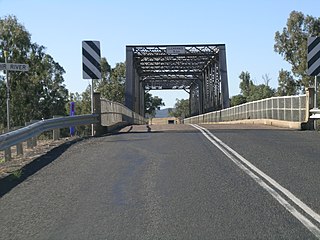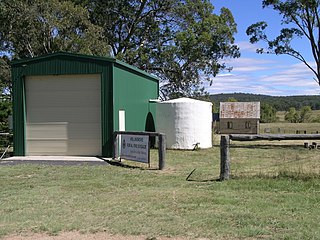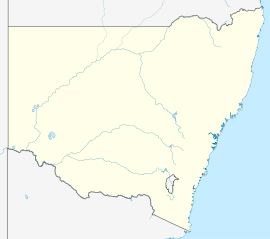
Grafton is a city in the Northern Rivers region of the Australian state of New South Wales. It is located on the Clarence River, on a floodplain, approximately 608 kilometres (378 mi) by road north-northeast of the state capital Sydney.

Gwydir Highway is a 568-kilometre (353 mi) state highway in northern New South Wales, Australia. The highway was named after the Gwydir River, which in turn was named after a locale in Wales.

Glen Innes is a parish and town on the Northern Tablelands, in the New England region of New South Wales, Australia. It is the centre of the Glen Innes Severn Shire Council. The town is located at the intersection of the New England Highway and the Gwydir Highway. At the 2016 census, Glen Innes had a population of 6,155.

Clarence Valley Council is a local government area in the Northern Rivers region of New South Wales, Australia.

Summerland Way is a 199–kilometre state route, designated B91, in New South Wales. It runs generally north from Grafton to the state border with Queensland just west of Mount Lindesay, and continues from there into Queensland as Mount Lindesay Highway. It was named as the region in runs through is a popular tourist area for people during summer.

Capertee pronounced is a village 46 km north of Lithgow, New South Wales, Australia. It is on an elevated site above the Capertee Valley. In 2016, the township had a population of 145 people. The Castlereagh Highway links Capertee with Lithgow to the south and Mudgee to the north. The township is surrounded by National Parks and grazing land. Principal employment is in coal mining, farming and tourism-related services. The Capertee Valley forms a part of the catchment area of the Hawkesbury River, but the village lies very close to the Great Divide watershed, with the Turon River catchment nearby to its west.

Conargo is a town in the Riverina region of New South Wales, Australia. The town is in the Edward River Council local government area. It is on Billabong Creek, a tributary of the Edward River. The nearest towns are Jerilderie and Deniliquin. At the 2006 census, Conargo had a population of 117 people.

Nambucca Heads is a town on the Mid North Coast of New South Wales, Australia in the Nambucca Valley. It is located on a ridge, north of the estuary of the Nambucca River near the Pacific Highway. Its 2021 population was 6,675, including 5,226 (78.3%) Australian-born persons and 672 indigenous persons.

Wee Jasper is a hamlet in the Yass Valley Shire in New South Wales, Australia, about 90 km north-west of Canberra and 60 km south-west of Yass. It is in the Goodradigbee valley at the western foot of the Brindabella Ranges, near Burrinjuck Dam. At the 2021 census, Wee Jasper and the surrounding area had a population of 127.

Harrow is a town in the Wimmera region of western Victoria, Australia. The town is located in the Shire of West Wimmera local government area, 391 kilometres north west of the state capital Melbourne, overlooking the Glenelg River valley. At the 2016 census, Harrow and the surrounding area had a population of 200.

Wellingrove is a village located on the Wellingrove Road about 20 kilometres (12 mi) north west of Glen Innes, New South Wales on the Northern Tablelands, New South Wales, Australia. At the 2006 census, Wellingrove had a population of 113.

Deepwater is a parish and small town 40 kilometres north of Glen Innes on the Northern Tablelands, New South Wales, Australia. At the 2021 census, Deepwater had a population of 456.

Nymboida is a rural village in the Northern Rivers region of New South Wales, Australia. It is about 21 kilometres south-west of Coutts Crossing, 44 kilometres south-west of Grafton and approximately 687 km north of Sydney. Nymboida is close to the challenging and popular white water rafting waters of the Nymboida River along the Armidale–Grafton Road. The village is in the Clarence Valley Council local government area.

The Glen Innes Examiner, previously published as the Glen Innes Examiner and General Advertiser, is an English language newspaper published bi-weekly in Glen Innes, New South Wales, Australia.
Augustus Ryan Fraser was a politician and pastoralist in New South Wales, Australia.

Colinton is a locality in the Snowy Monaro Region, New South Wales, Australia. At the 2016 census, it had a population of 127. There was once a village and railway station of the same name.
George James MacDonald was a Commissioner of Crown Lands in the British colony of New South Wales where he founded both the city of Armidale and the town of Balranald. He is mostly remembered for his role in leading a contingent of Border Police troopers in a large massacre of Indigenous Australians in the Clarence River region. MacDonald was also considered a talented linguist and writer, producing several published works of poetry and prose reflecting on his experiences in Australia.
Dalmorton is a locality in the Northern Rivers region of New South Wales, Australia. There once was a village of the same name, which was associated with gold mining. Much of the area of the locality is now reserved as National Parks or State Forests. At the 2016 census, the population of Dalmorton was four.
A referendum concerning the creation of a new state of New England from the northern area of New South Wales was put to voters on 29 April 1967.
Cangai is a locality in Clarence Valley Council LGA, within the Northern Rivers region of New South Wales, Australia. There was once a mining village of the same name, now a ghost town. Cangai lies near the Gibraltar Range, within the catchment of Mann River, which flows through the eastern part of the locality. The Gwyder Highway passes through it. It is approximately 70 km west-north-west of Grafton by road.
















